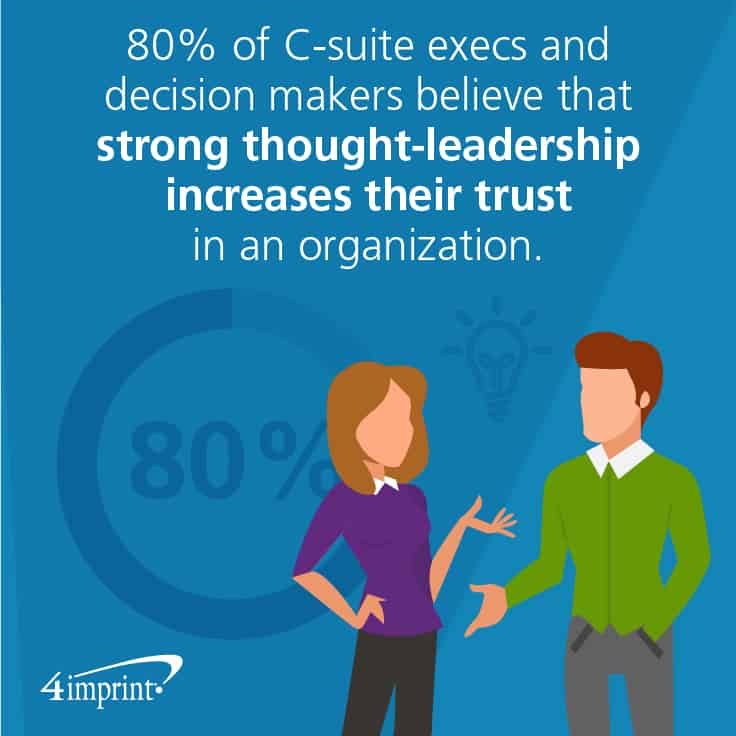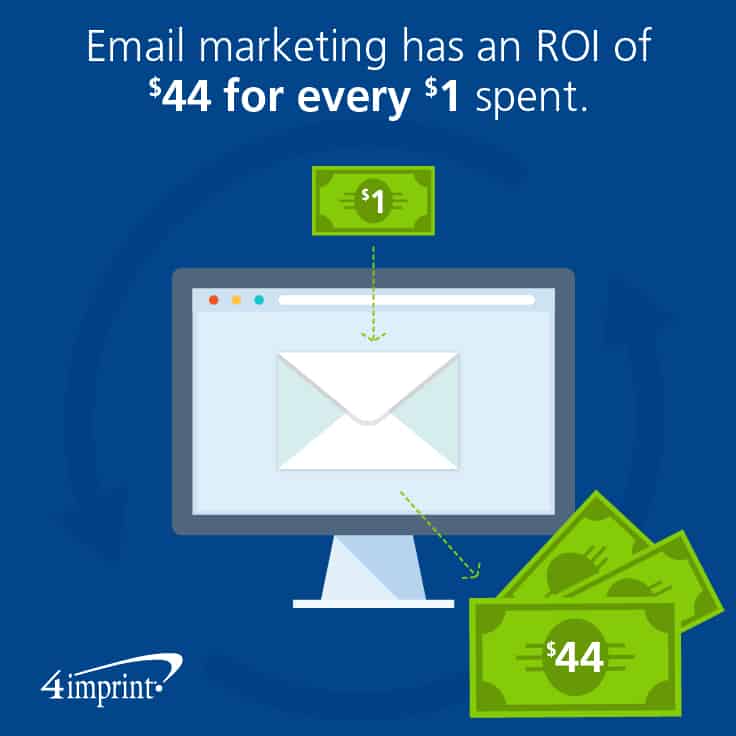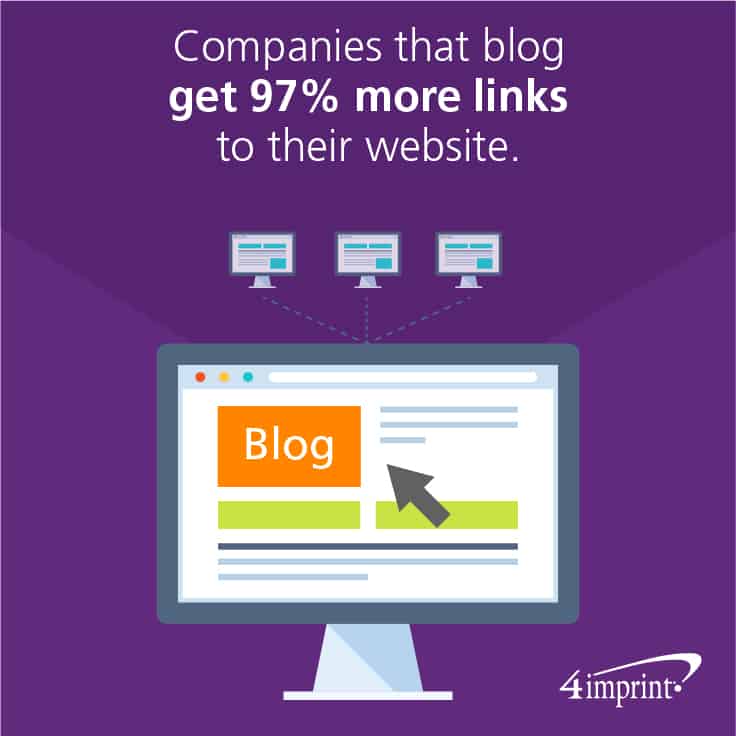Every business has a built-in knowledge base. And that knowledge is incredibly valuable.
One study on the B2B sales process found that 80 percent of C-suite executives and decision makers felt that strong thought-leadership pieces increased their trust in an organization, and more than 51 percent said it was essential when selecting potential business partners.

What’s the key takeaway? Sharing knowledge can help companies expand existing customer relationships and create new ones.
In this Blue Paper, we’ll discuss how you can improve connections with your customers by sharing knowledge of your industry. By using in-person presentations and seminars, webinars, online learning opportunities, blogging and training giveaways,your company can demonstrate its expertise and become the go-to choice in your industry.
Define your ideal customer
Before you begin sharing knowledge, it pays to know about your ideal customer. Build a persona of your most profitable customer. Who are they? What role do they play in their company? How do they make decisions?
Creating a profile of the ideal customer allows you to determine what kind of content is going to attract and assist them. Are they professional or amateur? Do they require specialized equipment you provide and knowledge on how to use it? How much money are they going to spend on your products or services, and how can you help them get the biggest bang for their buck?
If your company has a broad scope of products or services, it may be necessary to come up with multiple personas, so you can build classes and blog posts around their individual needs. Why go through all this effort? Because as Forbes® noted, “When you know your audience, you will grow your audience.”
Create valuable content
Once you know whom you’re trying to attract, find out what attracts them. From a customer service perspective, the most important consideration is always: Does this make the customer’s life easier? If your content simplifies a difficult concept or teaches them to do something they value, you’ll naturally attract their attention.
Creating a profile of your ideal customer can help you choose topics and determine the most effective training format. For example, 59 percent of executives say they would prefer to watch a video to reading text.

However, written content is generally easier to follow when skimming for specific information, and reading allows for more time to absorb complex topics. Determining the complexity of your topic is key to choosing your teaching method.
In-person classes and educational opportunities
There are other factors to consider as well. A series of educational videos might be too expensive to produce, but in-store classes for local customers might work well with your budget and your ideal customer’s schedule.
While there are advantages to both communicating online and communicating in person, studies have shown that in-person communication leads to more positive results. So, take advantage of opportunities to connect with customers face-to-face.
Speak at a conference or trade show
According to research conducted in partnership with the Association of Management Consulting Firms, one of the best ways to establish thought leadership is through “conference presentations by subject matter experts.”
In simple terms, giving a presentation at a conference or trade show is an excellent way to gain visibility for your company, product and expertise.
It’s also a great opportunity to provide people with a long-term reminder of your business. Along with your business card, hand out the Razzle Jotter with Pen so your audience can take notes about your presentation. The gift and those notes will remind customers of the solutions you offer.
Give a local presentation or demonstration
Handling your own presentation can be a budget-conscious way to establish your company as a go-to in your industry. A class or seminar can often be repeated in multiple venues, allowing you to connect with lots of potential customers.
For example, if you run an accounting firm, there are multiple training and educational seminars you can offer for businesses and individuals. You may want to talk about preparing for tax time, budgeting or new regulations that are affecting businesses.
As they’re leaving, send your audience off with a Stress Reliever. It’s the perfect reminder that you can help them take the stress out of finances and accounting.
Reward people for participation
The most interesting presentations are those that invite audience participation and questions. But sometimes the audience is a bit shy. Draw them out by offering participation rewards.
Valerie Jackson, Director of Marketing at Visible Equity, a company that sells financial analysis software, used the Nike® Workout Plus Duffel as a prize during their software training events. The company offers multiple training camps throughout the year.
“Our theme this year has been ‘Step Up Your Analytics Game’ just as a tagline,” Jackson said. “It’s a full day of training, where we dive deep into our analytics software, train attendees on best practices to manage their loan portfolios and go over new industry requirements. We give out the Nike bags to those who answer questions correctly during the training, or who do something to win them. We have funny competitions and the winner will receive the bag. We also give them away for webinars.”
They don’t let people know in advance that they can win prizes at the trainings—so winners are definitely surprised and appreciative of the swag.
“It’s more of a prize giveaway—they don’t expect it, but love it,” Jackson said.
Make people aware of your classes
Whether you’re presenting as part of a larger conference or offering a series of classes at your place of business, making people aware of the opportunity can be challenging. Use several mediums to spread the word—mail, email and social media being the three most popular choices.
One of the most significant advantages of sending personal, mailed invitations is that it allows you to make a strong, long-lasting impression. By including training giveaways as an event reminder, you increase your chances of being remembered. For example, sending a Mailable Series Seed Packet – Money Plant and a note that explains how the educational opportunity may help them grow their business—and profits— can be a fun way to catch their attention.
Offer registration gift packets
Another way that training gifts can help customers retain the knowledge they’re learning that day is to present them with a Basic Meeting Padfolio at the start of the presentation, complete with a packet of useful information and a way to take notes.
Try to tie your giveaways to your business. For example, if you’re a local hardware store or do-it-yourself center, offer an Inkbend Standard Special Shapes – Paint Brush. It’ll remind them of you every time they use it.
Encourage people to learn with training gifts
If you’re planning a series of educational sessions, you may want to use an incentive to encourage them to participate in several sessions.
Barb Flowers is the Office Manager/Resource Coordinator at Community Family Partnership of Network180, a grant-funded organization that works with children with behavioral and mental health issues. They recently decided to use a punch card and a Hanes® Tagless T-Shirt to encourage more parents to participate in their programming.
“We do parent training once per month,” Flowers said. “We also run classes, where we bring in a speaker for six to eight sessions so that parents can learn about a topic, like keeping safe on social media or parenting children with Reactive Attachment Disorder (RAD). We also do a big family dinner once a month, with different themes and activities.”
To encourage parents to attend as many sessions as possible, they started offering the Engaged, Equipped and Involved Connect Card.
“Every time they come to an event, whether it’s a class, a family dinner or any of our other programming, they get a punch,” Flowers said. “When they have six, they get a T-shirt. We wanted to use that particular item first because we wanted the people who use our programming to get the sense of belonging to something.”
Thanks to the punch card, T-shirt and other gifts, attendance at their events has improved.
“We really want to tell people, ‘We want you here. You’re welcome here,’” Flowers said. “People always say, ‘Been there, done that, got the T-shirt,’ and here, we really mean it!”
Live webinars, video content and email training
When people think of online classes, they usually think of a webinar or other live online class where they can learn about a topic from the comfort of their desk.
While webinars are an extremely valuable tool, online training can also be accomplished via email training or a series of prerecorded videos. Consider costs and time when choosing the best format for your educational material.
Webinar tips
While face-to-face seminars may have certain advantages, webinars can make it easier for customers to take part. They also allow the presenter to address customers in multiple locations simultaneously.
Here are a few tips to attract the largest number of attendees:
- Attendance is always lowest on Fridays and Mondays, so hold your presentation on Tuesday, Wednesday or Thursday.
- Statistics show that many people will leave a webinar after about 22 minutes. Try to keep your event to roughly 20 minutes.
- Make the webinar available for viewing after the initial presentation is over. This will allow people who were unable to attend to still get the information.
Online video courses
Unlike webinars, prerecorded video courses have the distinct advantage of allowing the user to move at their own pace during times that work best for them. Video courses can be paused, rewound, watched again for review and integrated with other material, such as online forms, quizzes and other documents that further explain the concepts being taught.
Online courses can also be designed for a variety of purposes and formats including:
- On-boarding: An online video or series of videos that teach people to use your product.
- Goal-specific: A quick boot camp that teaches a skill or set of skills. For example, an hour-long presentation by an accountant that offers end-of-year tax tips.
- Subject-specific: Allows you to build a larger course on a single topic, i.e. painting techniques for beginners.
- Training library: Instead of just offering one course, offer a variety in an online learning library that can be accessed by customers 24/7/365.
- Mini class: A short class that teaches a single skill in 10-60 minutes.
- Partner course: If your customers are interested in a particular topic or skills set that your company doesn’t provide, partner with a company from another industry and work with them to create a presentation.
While building a video library can come at a substantial cost, it does have one more advantage over webinars—they are easier to change. Replacing a small, outdated portion of the video may be all you need to do to update your library, rather than having to rerecord an entire webinar.
Email courses offer a big return on investment
Email marketing provides an impressive ROI, with a return of 44 dollars for every dollar spent. What’s more, 95 percent of people who choose to accept email from a brand find the information useful

Subsequently, courses delivered by email are a perfect storm of benefits for both client and customer—they’re low-cost and rich in information. Plus, they keep fresh material in customers’ inboxes for weeks at a time.
KickoffLabs offers some simple tips for creating a great email course:
- Start with an outline: Your course can’t cover every single aspect of any topic, so limit your course to the most important ones.
- Make it short: Set each course at about five to seven lessons, with each email being less than 1,000 words. That puts your entire course at about seven, eight-minute reads—about 56 minutes total.
- Make it valuable: Fill your course with useful information to keep customers coming back lesson after lesson.
- Make it action-oriented: End each lesson with an action the reader can perform to keep them engaged and excited for the next lesson.
Give people a kit for your courses
While webinars, video training and email can be excellent ways to educate customers, being unable to interact directly with your customer can make it harder to create a long-term impression.
One way to create a more prominent and lasting impression is to mail customers training gifts for their online courses. By capturing a physical address from them at sign-up, you’ll be able to offer an item that will help them get the full benefit of your online courses—and keep your brand readily available.
Dino Ear Buds with Case are ideal for online webinars, as the earbuds come with a built-in microphone for when the participant wants to ask questions. And with many of your customers using tablets and smartphones to take your courses, the Media Stand with Adhesive Notes is the perfect place to set their devices. It also gives the user an easy way to scribble ideas they get from your presentations.
Sharing knowledge through blogging
One survey showed that the top way to establish your business as a thought leader was search engine optimization—and blogging is an excellent way to raise your visibility during a web search. One expert compared it to fishing. Having more hooks in the water increases your chance of catching a fish; just as having more online content increases your chances of finding new customers.
And that’s not the only benefit of blogging. Studies show that companies that blog get 97 percent more links to their website.

Over time, your blog will bring in more customers while helping establish trust in your business.
Offer rewards (and training giveaways) for following along
Once you’ve drawn your audience in with content, offering simple and useful training gifts is an excellent way to keep your brand top of mind. Plus, offering customers a gift helps you capture contact information for future promotions.
If, for example, you sell school materials, send rulers that are useful and fun. Those are two of the most common reasons people hold on to promotional products. Consider the Wooden Mood Ruler, which changes color with the heat of their hand, or a Magnetic Ruler that they can keep on their fridge.
Thought leadership + training giveaways = great customers relationships
Demonstrating thought leadership with short videos, in-person presentations, blogs and training giveaways can help you build trust and earn customers. With every class and piece of content you create, you’ll help make your customers’ lives a little easier—and remind them that you have the knowledge and expertise to help them with any problem they encounter.

